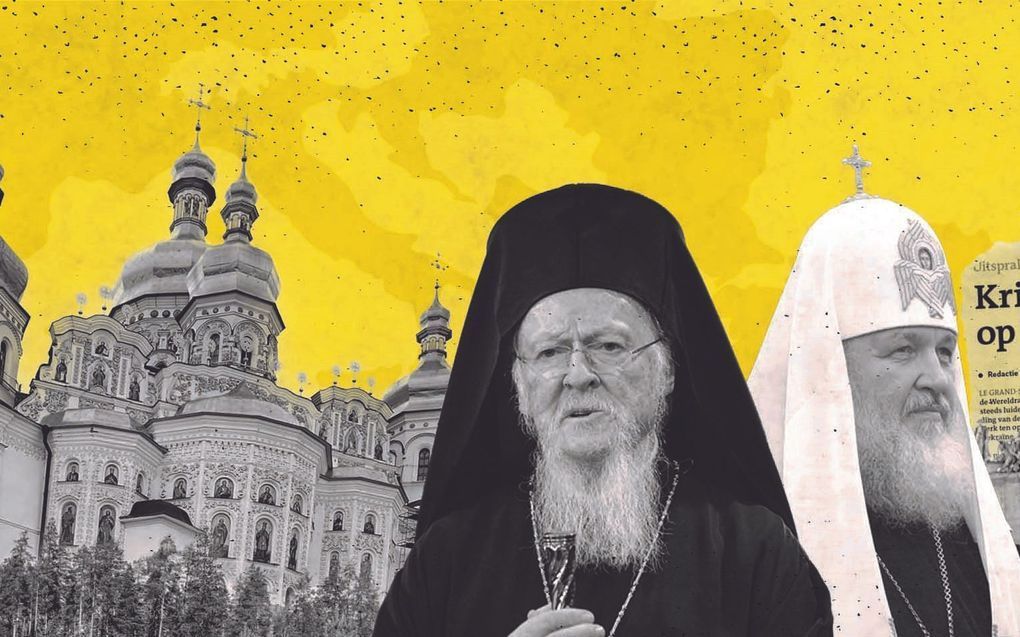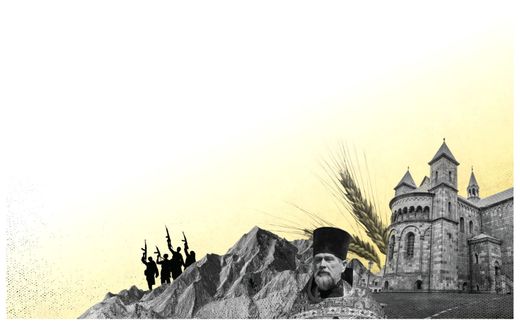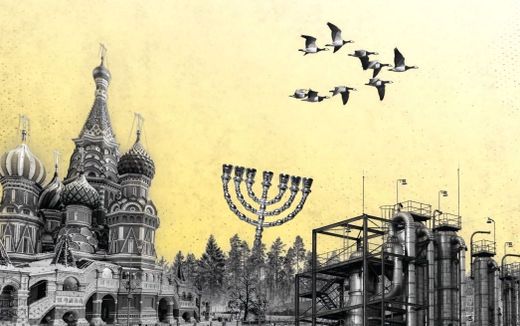When the 'Holy Russian' beats the Holy Spirit (part 3/6)
15-04-2022
Opinion
Jakob Hoekman, RD

Illustration RD, Corné van der Horst
Opinion
That Patriarch Kirill, how does he think? How can the head of 150 million Russian Orthodox believers fully support a bloody invasion of a neighbouring country that is also predominantly made up of Orthodox believers?
In search of an answer to that question, I delved deep into church history. Because if you don't understand the Orthodox world, you won't understand Kirill's attitude either.
So first the question: what is that Orthodox Church of Russia and Ukraine? I myself regularly use a handy model for articles and lectures that describes the entire world church in a single stroke of the pen. That is the model of the three lungs or three traditions: the Latin or Western, the Greek or Eastern, and the Syrian or Oriental tradition.
The oldest but also smallest and most unknown lung is the Syrian one. This movement consists of very different churches that go back to the cradle of Christianity, such as the Syrian Orthodox Church in Syria and Iraq and the Coptic Orthodox Church in Egypt.
The other two church traditions have grown much larger than their Syrian sister. Rome is the largest with more than 1.2 billion souls. The Roman Catholic Church may historically be called the Church of the West, and today it is present all over the world.
But when Rome fell in 476 and the Western Roman Empire collapsed, that future didn't look so bright. Fortunately, there was the city of Constantinople, seat of the Eastern Roman or Byzantine Empire. There, in what is Istanbul now, the flame of the Roman Catholic faith was kept burning. Constantinople was rightly called the second Rome.
In the centuries that followed, however, the Western and Eastern traditions grew further and further apart. Until the bomb exploded. In 1054, the bishops of Rome and those of Constantinople pronounced curses upon each other. The greatest schism in church history was a fact. The Greek sister went her own way from now on.
Kievan Rus
But did that Greek sister have a future? That was just the question. Since the 7th century, many Orthodox countries have been under attack from a new religion from the Arabian desert: Islam. The Syrian sister had already been almost wiped out, but Constantinople, the second Rome, was also attacked again and again from 667. The city lasted for a long time, but in 1453 it finally lost out. The cradle of Eastern Orthodoxy had fallen.
Fortunately, the flame was handed over to yet another city in time, just as Constantinople itself had taken over the flame from Rome a thousand years earlier. That city was Kiev (or Kyiv) – the same Kiev where in 882 the seeds of the later Russian Empire had been sown. The same Kiev where in 988 Prince Vladimir had converted to Byzantine, Eastern Orthodox Christianity, and his Kievan Rus with him. Kiev is the cradle of the supreme Russian Orthodoxy.
It is true, officially Ecumenical Patriarch Bartholomew I of Constantinople is still the head of Orthodoxy. But in practice, the Russian Patriarch Kirill is much more powerful. With 150 million Russian Orthodox believers, he leaves a huge mark on the total of 300 million Orthodox believers worldwide.
Or busy, rather. Because in October 2018, the unimaginable happened: the Russian Orthodox Church severed ties with the Patriarchate of Constantinople and has since officially ceased to be part of the Eastern Orthodox family. The reason: Kiev. Because who owns the church in Kiev? Moscow, says Patriarch Kirill. Ukraine, says the Ukrainian Patriarch.
Patriarch Bartholomew of Constantinople accepted the Ukrainian wish, whereupon Moscow left the Orthodox house with a quarrel. It received a modest report here and there in the media, but it marked a landslide in the Orthodox world that has been compared to the Great Schism of 1054. The largest of all member churches started for itself.
Holy Russian
Meanwhile, the Russian Orthodox Church became more and more radical. Today, in revenge against the rest of the Orthodox world in general and against the Orthodox Church of Ukraine (OCU) in particular, it opens its own dioceses everywhere, including in Africa. Orthodoxy must emphatically continue as Russian Orthodoxy, with Moscow once more as the third Rome.
Patriarch Kirill and his followers justify this ultra-nationalist theology by appealing to the ideology of “Holy Russia”, or also “Holy Russian.” This concept encompasses the entire Russian sphere of influence, including Belarus and Ukraine. Ukrainian Kiev is the spiritual centre in this worldview, just as Moscow is the political centre.
This "holy Russia" is called to be the true representative of Orthodoxy and to fight against all kinds of erring churches, especially those in the West, which have fallen for the idol of liberalism. At the beginning of March, Patriarch Kirill made this explicit again in a sermon in which he sided with Putin and in which the West was criticised for promoting gay prides.
The thinking behind this has recently been contradicted by the Orthodox Christian Studies Center. In a statement signed by more than 500 orthodox theologians –including from Russia itself– they reject Holy Russian theology. It is a “false teaching”, an “indefensible heresy”, partly because Christ's Kingdom is not of this world. And also, because in Christ everyone is equal.
The theologians “beg all to whom this statement pertains to return to the unity of the Spirit through the bond of peace.” But because the Russian Orthodox church leadership, together with Putin, has been propagating this theology for at least twenty years, it is not to be expected that Patriarch Kirill will suddenly see the light at this point. Unless a miracle happens of course. Fortunately, Orthodox history is also full of this.
This article was translated by CNE.news. It was published previously in Reformatorisch Dagblad on March 26th, 2022.
Related Articles






